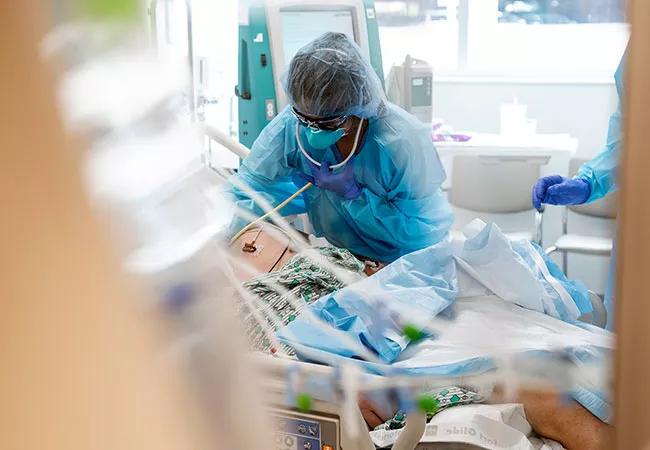Healthcare workers with COVID-19 less likely to require hospitalization than non-healthcare workers

Workers in a large healthcare system have similar odds of testing positive for COVID-19 as the general population; however, healthcare workers are less likely to require hospitalization, according to the findings of a retrospective study conducted at Cleveland Clinic.
Advertisement
Cleveland Clinic is a non-profit academic medical center. Advertising on our site helps support our mission. We do not endorse non-Cleveland Clinic products or services. Policy
“Among the most important concerns in the COVID-19 pandemic is its impact on healthcare workers,” says Anita Misra-Hebert, MD, first author on the paper recently published in the Journal of General Internal Medicine. “We conducted this study to further elucidate that risk.”
Research collaborators used data from Cleveland Clinic’s COVID-19 Registry to better understand the risk of COVID-19 infection in healthcare workers, and subsequent risk for hospitalization or intensive care unit admission for those healthcare workers who tested positive. The registry contains data on more than 72,000 individuals who were tested for COVID-19 between March and June 2020, 6,145 of whom were healthcare workers.
According to Chief Research Information Officer Lara Jehi, MD, the registry was initiated when Cleveland Clinic began testing patients for COVID-19 in early March 2020. Cleveland Clinic collects 400–600 data points per patient, including clinical characteristics, co-morbidities, medications and outcomes.
“Our goal was to leverage the resources of the newly created Chief Research Information Office to effectively and efficiently build a data resource that enables the study of key research questions related to COVID-19. This paper is one of 143 research projects currently supported by the registry, many of which have already been published in high-impact academic journals,” says co-author Dr. Jehi.
While healthcare workers faced similar odds of testing positive for COVID-19 as non-healthcare workers, those considered to be patient-facing healthcare workers were more likely than non-healthcare workers to test positive for the virus. COVID-19 symptoms were somewhat similar in both cohorts and included cough, fatigue, diarrhea, loss of appetite and vomiting; however, a lower proportion of healthcare workers developed fever or shortness of breath.
Advertisement
“We were able to control for significant baseline differences in characteristics of our healthcare workers who had positive tests compared with non-healthcare workers using statistical methodology, which allowed for unique insights,” says Dr. Misra-Hebert.
Healthcare workers were less likely than the general population to be hospitalized with COVID-19 infection, perhaps because healthcare workers tended to be healthier. A lower proportion of healthcare workers had co-morbidities, including chronic obstructive pulmonary disease, diabetes, coronary artery disease, heart failure, cancer or immunosuppressive disease. Healthcare workers also had a higher median income and were more likely to be nonsmokers, which may have contributed to their outcomes.
It’s important to note that these findings include only Cleveland Clinic caregivers, and the results may not be generalizable to other healthcare environments that may not have adequate levels of personal protective equipment.
“These results remind us that even in healthcare, the basics are crucial,” says co-author Aaron Hamilton, MD, MBA. “Patterns of transmission tend to reflect our compliance with risk mitigation efforts, including wearing face masks, maintaining physical and social distance when possible, and hand hygiene.”
“At Cleveland Clinic, we use the best available data and evidence at every turn to optimize safety. Our approach throughout the pandemic has been to keep caregiver and patient safety at the forefront of every conversation. As we have learned more about the unique vulnerabilities to patients and caregivers associated with COVID-19, we have adjusted our approach. We instituted universal pandemic precautions (UPP), after these findings were reported. In addition to donning ear-loop masks, UPP requires eye protection to decrease exposure. The initiation of UPP has been temporally related to a decrease in caregiver exposures and caregivers testing positive for COVID-19. Although we cannot say the correlation is causative in nature, anecdotal reports from our caregivers confirm their feelings of increased safety,” Dr. Hamilton concludes.
Advertisement
Advertisement

Patients report improved sense of smell and taste

Clinicians who are accustomed to uncertainty can do well by patients

Unique skin changes can occur after infection or vaccine

Cleveland Clinic analysis suggests that obtaining care for the virus might reveal a previously undiagnosed condition

As the pandemic evolves, rheumatologists must continue to be mindful of most vulnerable patients

Early results suggest positive outcomes from COVID-19 PrEP treatment

Could the virus have caused the condition or triggered previously undiagnosed disease?

Five categories of cutaneous abnormalities are associated with COVID-19